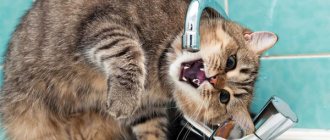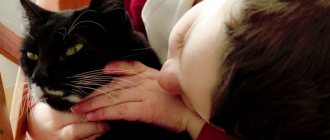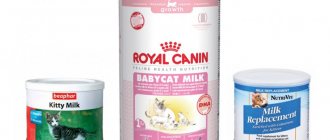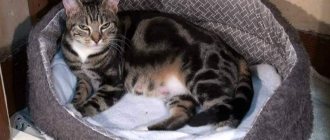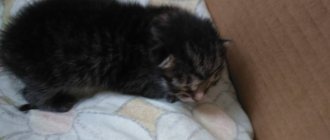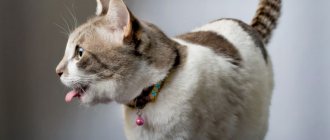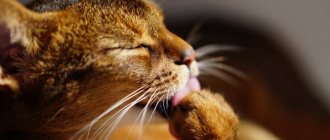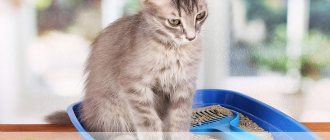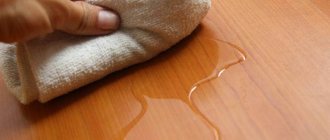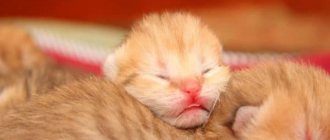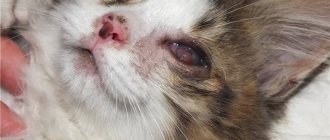The mother cat provides everything for her newborn kittens. A newborn cannot regulate temperature, see, hear, or even defecate without the mother's help. Importantly, they cannot eat. Cats are mammals, so called because they have mammary glands. These glands allow them to feed their young with breast milk, which they produce themselves. This breast milk is more than just food. The first milk, called colostrum, that cats give to their kittens is rich in essential nutrients that help strengthen the vulnerable young cat's immune system. The milk will change slowly, but will still be packed with nutrients.
If the mother cat does not give milk, the kittens are in serious danger. Their ability to survive is at risk. We explore possible reasons why a mother cat is not producing milk to help understand what to do in the worst case scenario.
When does a cat produce milk?
Typically, cats produce milk immediately after their babies are born.
At this time, the animal’s body releases the hormone oxytocin, which stimulates lactation. Also, a few days before the onset of labor, the first drops of colostrum may be released from the nipples. For various reasons, milk production may begin only 2-3 hours after all kittens are born. Babies instinctively find the nipples and begin to stimulate them, which allows milk to flow into the mammary glands.
Normal lactation - beginning, process, completion
Normally, a cat's lactation begins immediately after birth or a few days before the birth of the offspring. Several complex mechanisms are responsible for the production of milk in the mother's body, but they all depend on hormonal levels.
From the first day of conception until the end of lactation, the level of oxytocin in the cat’s body increases. The amount of this hormone is constantly increasing. A critical concentration of oxytocin leads to the initiation of labor and active lactation. In fact, if everything goes naturally, the cat’s milk actively comes in during contractions and pushing.
A few days before giving birth, a clear discharge may ooze from your cat's nipples, indicating that the mammary glands are open. This is a good sign, since nothing will interfere with the flow of milk. During this period, the cat intensively licks the nipples, which stimulates increased blood circulation in the tissues.
After the birth of the first kitten, the cat gnaws the umbilical cord, eats the afterbirth and pushes the baby towards the nipples. The process of feeding a kitten serves as additional stimulation for the onset of new contractions, and if all kittens are born, for the contraction of the uterus to a normal state.
In the first 4–5 days, the young mother feeds the babies every 2–3 hours. Note that immediately after childbirth, the mother’s body produces colostrum, not milk. In composition, colostrum is more saturated and contains a lot of:
- Nutrients (proteins) – a source of nutrition.
- Friendly lacto- and bifidobacteria - after birth, there are no bacteria in the intestines of kittens, and the process of further digestion depends on what microflora gets into it. Colostrum contains optimal microflora; statistics show that almost all artificially fed kittens suffer from dysbiosis.
- Antibodies - during the entire period of feeding and until about 3 months of life, kittens do not have their own immunity; they receive antibodies from the mother. After the end of feeding, the concentration of antibodies in the blood of kittens decreases, they become defenseless against viruses and infections. For prevention, kittens at the age of 3–4 months begin a course of basic vaccination.
- Water – newborn kittens, like their mother, experience dehydration in the first hours after birth. For kittens, this condition is considered more serious, so the mother’s body sacrifices itself to save the offspring. Your task is to take care of mom and help her restore water reserves in her body.
The cat independently decides how long to feed the kittens. Typically, a young mother begins to avoid feeding when the kittens reach the age of 1-2 months. At this point, the cat has a natural decrease in active lactation.
At about one month of age, babies' incisors begin to emerge, the cat experiences severe discomfort during feeding and begins to avoid babies. The kittens have no choice but to look for other food sources.
At about one month of age, the owner needs to start feeding the babies. If the cat is kept on industrial food, then the kittens are fed with special baby pate. If the animal eats natural food, the kittens are given boiled minced meat, broth, dairy and fermented milk products.
How to tell if a cat doesn't have milk
The main sign of a well-fed kitten is silence. If babies sleep peacefully and wake up only to eat a hearty meal, it means that the mother is producing enough milk, and the owner does not need to worry.
If the kittens are restless, constantly squeak, crawl around the box or maternity box and often suck on the nipples, this indicates that they are hungry. These babies have sunken tummies and grow slowly. Many owners wonder: what to do if the cat does not have milk, and how to help her.
INTERESTING! You can determine whether your pet has milk in the following way. It is necessary to gently press on the animal's nipple. If white drops appear on it, milk is being produced.
Signs of underfed kittens
Timely detection of newborn kittens not eating enough is very important for preventing mortality and morbidity among offspring
How can you tell if a cat doesn't have milk? The following signs that you need to pay attention to will help with this:. When you press on the nipple, a drop of milk should appear
This manipulation needs to be done at the time of feeding, since the cat’s milk is not constantly in the mammary glands, but when the kittens stimulate the nipples. And if a drop of milk does not appear at this moment, it is worth taking a closer look at the kittens’ behavior
When you press on the nipple, a drop of milk should appear. This manipulation needs to be done at the time of feeding, since the cat’s milk is not constantly in the mammary glands, but when the kittens stimulate the nipples. And if a drop of milk does not appear at this moment, it is worth taking a closer look at the kittens’ behavior.
Hungry babies are restless, look for nipples, squeak, and do not sleep after feeding. Hungry or underfed kittens crawl around looking for a food source. Well-fed cubs fall asleep almost immediately after the next intake of milk, sometimes right at the mother's nipple.
Some cats, if they do not have milk, are reluctant to be near kittens and abandon them. Other animals with agalactia continue to “feed” their offspring, take care of them, warm them, and lick them. In this case, the behavior of the kittens will be an indicator of underfeeding.
More reliable information that a cat does not have enough milk can be obtained by regularly weighing the babies. During the day, with a normal supply of food, the cub gains at least 10 grams in weight. If within a few days the increase is less than this or is completely absent, this is a serious symptom that the kitten is starving and its life is under threat.
For what reasons may a cat lack milk?
There are several reasons why a mother cat does not produce milk:
- Retention of the placenta after the end of labor. In order for it to come out, the animal is given an injection of oxytocin or calcium borogluconate. These drugs stimulate contraction of the uterus, causing the placenta to be expelled. If this does not happen, veterinarians perform surgery.
- Pyometra or endometritis. After giving birth, a cat's uterus may become inflamed, with pus accumulating in its cavity. This happens for two reasons: a greatly distended uterus or the afterbirth remaining in it. Pyometra can be recognized by the cat's behavior: it becomes restless, breathes heavily, hides in dark corners, and white discharge appears from the noose. Pyometra is treated with antibiotics (at an early stage) or surgery if the disease is already very advanced.
- Eclampsia. This condition is caused by an acute calcium deficiency in the animal’s body. Eclampsia develops during the first two days after birth. The cat experiences convulsions, and without help it may die suddenly.
- Mastitis. With this disease, the cat's mammary glands become inflamed. They become hard and hot and milk is not produced. The animal experiences first discomfort and then severe pain in the chest area.
- Stress. Cats giving birth for the first time can be very nervous and even aggressive. They do not understand what happened to them, they worry, they may leave the babies and refuse to feed them. This happens because the hormone oxytocin is not produced immediately, and therefore milk does not yet begin to flow into the mammary glands.
- Lack of maternal instinct. Some cats can abandon their offspring immediately after they are born. The milk production process does not start in a timely manner, and the animal refuses to be near the babies. You can try to awaken the maternal instinct in your pet. To do this, the kittens need to be placed close to the nipples, and the cat must be carefully held and calmed.
- Incorrect cat diet before and during birth. A cat may not produce milk if she does not get enough nutrients from her food. It is very important to correctly prepare the diet of a nursing animal and prepare milk mixtures.
Premature birth
Normally, a cat gives birth without complications, and she is able to prepare the site herself and give birth to kittens. However, in some cases, hormonal imbalances occur, which lead to miscarriage and premature birth.
Symptoms of miscarriage:
- increased body temperature;
- restless behavior;
- frequent contractions;
- blood and mucus are released from the genitals;
- yellow or clear water appears.
Veterinarians identify several main causes of premature birth:
- death of kittens in the womb. This symptom is difficult to diagnose in advance. However, cats instinctively sense non-viable offspring, which must be removed from themselves. The veterinarian can try to stop the contractions, then the cat will give birth later, but the kittens will still die;
- an infectious disease that a cat picked up while mating or walking outside. In this case, the birth is not stopped, as there is a risk of harming the cat. She miscarries prematurely, resulting in dead kittens. If the body managed to survive, then the cat will be able to carry the rest of the babies until a certain period;
- Placental abruption at less than 56 days of gestation ensures death for kittens. In this case, you should not waste time, as this often causes internal bleeding.
Important! If premature birth begins, it is first of all important to help the cat. You need to take her to the vet for an examination.
When it is not possible to go to a doctor, it is necessary to conduct a consultation by telephone. All this time, the owner must be with the cat, calm it down and stroke it. The animal can independently delay or stop labor if necessary. To relieve early contractions, it is recommended to use no-shpa, but you should not do this without a doctor’s permission.
Kittens can survive for more than 51 days; if miscarriage occurs earlier, then there is no point in saving them.
If it was not possible to determine the cause of premature birth, then there is no need to interfere with the process. If babies are born alive, they have every chance of a full life. If the offspring turns out to be dead, they are immediately removed from the mother.
When a cat has successfully given birth early, it is still necessary to take her to the veterinarian. It is best if the doctor comes to your home, since going to hospitals during the postpartum period will become stressful for the cat.
What to do if your cat has little or no milk
If a mother cat does not have milk, first of all you should make sure that she does not have any pathologies. The box with the offspring and pet is placed in a quiet and dark place. The cat should not be nervous or stressed.
If the animal does not have enough milk, breeders recommend using the following recipes:
- Nettle inflorescences. They are first collected, washed and dried. The inflorescences are then ground with a coffee grinder into flour and added to the animal’s food.
- Wild raspberry leaves. A decoction is prepared from them, which is given to the mother cat, 15 ml three times a day.
- Walnuts, sour cream and milk. Nuts (10 pcs.) are crushed, poured with boiling milk (500 ml) and left to infuse for 3-4 hours. After this, the mixture is filtered. After the infusion becomes warm, add a couple of tablespoons of thick sour cream. The mixture is mixed well, wrapped in a blanket and left for a day to ferment. This yogurt is fed to the animal.
- Carrots and sour cream. The fresh vegetable is grated on a fine grater or ground using a blender and mixed with sour cream.
- Quail eggs. Egg shells are washed and dried well. It is then ground to a powder using a coffee grinder. The resulting mixture is combined with thick village sour cream and given to the cat.
- Cream, eggs and glucose. One quail egg is mixed with 20 ml of cream 10% and 5 ml of glucose 5%. This mixture is given to the cat every day immediately after the kittens are born for a week, then it is fed every 3-4 days.
Lactation is well stimulated by drinking plenty of fluids, a calm environment and adequate, balanced feeding. You can also offer your pet infusions and decoctions of herbs: nettle, dandelion, anise, cumin, catnip, fennel.
Many breeders recommend giving a nursing cat warm black, weak tea with a small amount of condensed milk. You can also switch your pet to a special diet designed for feeding lactating animals: Royal Canin BABYCAT, 1st Choice Kitten CHATON, etc.
REFERENCE! Fospasim and Ovariovit will help stimulate milk production. These drugs are administered subcutaneously to the animal in a dosage of 1 ml. The course of application is 1-2 weeks.
Feeding a nursing cat
A nursing cat is fed more often: up to 6-7 times a day, and portions should be small. The volume of food is increased by 10-15% of the usual daily intake.
The natural diet of a nursing cat-mother should consist of the following products:
- meat (veal, rabbit, turkey) and offal (liver) - up to 50% of the total daily requirement;
- boiled fish without bones - it can replace meat 1-3 times a week;
- dairy products (cottage cheese, yogurt, low-fat cream) – up to 30% of the daily requirement;
- quail and chicken eggs, boiled or raw – 1-2 pcs. in Week;
- chopped vegetables – up to 10%.
If a cat eats natural food, it must be given vitamin supplements intended for nursing animals, for example, Farmavit NEO for pregnant and lactating cats, 8 in 1 Excel Brewers, etc.
The lack of milk in a pet that has given birth should alert the owner. This phenomenon may be the result of stress, in which case rest and good nutrition will help. If milk is not produced due to pathology, the animal must receive veterinary care within 1-2 days after birth.
What food and how much should you give your kitten?
The daily weight gain of a kitten is about 20 grams. Each gram of increase entails an increase in the amount of mixture by 4-5 grams. A more detailed feeding schedule is as follows.
A kitten aged 1-2 days should drink 30 grams of mixture per 0.1 kg of weight. Feeding should be done every 2 hours. A kitten aged 2-4 days should drink 30 grams of mixture per 0.1 kg of weight. Feeding should be done every 2 hours during the day and every 3 hours at night. A kitten aged 5-13 days should drink 38 grams of mixture per 0.1 kg.
Feeding should be done every 4 hours. A kitten aged 13-22 days should drink 46 grams of mixture per 0.1 kg of weight. Feeding should be done every 4 hours. From the 15th day, give the kitten liquid milk porridge with an egg. From day 22, offer other products - beef and fish minced through a meat grinder, baby food, low-fat cottage cheese, egg yolk.
After feeding, check that each kitten has been fed. Well-fed kittens sleep, but hungry kittens scream, crawl away and try to suck the outstretched finger. Be sure to feed hungry kittens. After 4 weeks, introduce the kitten to the bowl by wetting its mouth with the mixture and bringing it to it

